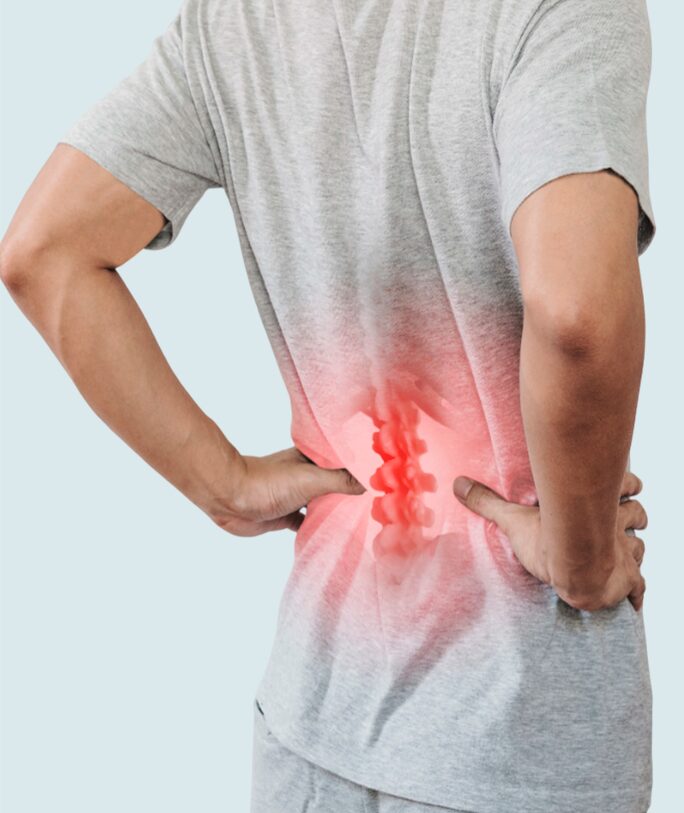MANAGING CHRONIC PAIN:
What to Know and
How to Feel Better

What to Know and
How to Feel Better
*The material provided in this blog is for informational purposes only and should not replace a consultation with a doctor. Every case is unique and should be evaluated by a healthcare professional. Vidamax Medical Center recommends consulting with a doctor to receive personalized advice.

Living with chronic pain can feel like dealing with an uninvited companion who follows you around all day. Some days, it might be a dull ache in the background. On other days, it can be an overwhelming, relentless presence that prevents you from doing what you love or even what you need to do. If you’re reading this, chances are you are all too familiar with this experience. You’re not alone. Chronic pain can impact everything from our physical health to our emotional well-being to our closest relationships.
Exploring how your body works and finding ways to deal with it can impact your well-being. If you experience pain regularly, it doesn’t have to dominate your life.
In this article, we’ll walk through the essentials of chronic pain, what it is, what causes it, and, most importantly, strategies that can help.
 CHRONIC PAIN:
CHRONIC PAIN:
WHAT’S GOING ON
AND HOW TO COPE
The world of wellness treatments is diverse, ranging from innovative solutions like ozone therapy and radiofrequency to advanced technologies like the Functional Magnetic Stimulation (FMS). Each treatment is designed to offer specific benefits for a healthy and active life. Today, we want to share our top treatments, which we are confident will help you regain your youthful glow.


CHRONIC PAIN:
WHAT’S GOING ON
AND HOW TO COPE

POSSIBLE CAUSES OF
CHRONIC PAIN:
- Past Injuries or Surgeries: Sometimes, pain lingers after an injury has healed or surgery has been completed.
- Ongoing Health Conditions: Conditions like arthritis, fibromyalgia, and diabetes can cause long-lasting pain.
- Nerve Damage: Nerve-related pain, such as that from sciatica or neuropathy, is often ongoing and hard to ignore.
- Unknown Causes: In some cases, the origin of chronic pain isn’t clear, which can be frustrating and isolating for those affected.
While chronic pain is complex, it can be managed with the right plan. Many people find relief through medical treatments, physical therapy, and lifestyle changes.
POSSIBLE CAUSES OF
CHRONIC PAIN:
- Past Injuries or Surgeries: Sometimes, pain lingers after an injury has healed or surgery has been completed.
- Ongoing Health Conditions: Conditions like arthritis, fibromyalgia, and diabetes can cause long-lasting pain.
- Nerve Damage: Nerve-related pain, such as that from sciatica or neuropathy, is often ongoing and hard to ignore.
- Unknown Causes: In some cases, the origin of chronic pain isn’t clear, which can be frustrating and isolating for those affected.
While chronic pain is complex, it can be managed with the right plan. Many people find relief through medical treatments, physical therapy, and lifestyle changes.

FRESH PERSPECTIVES
ON PAIN ASSESSMENT
Every person perceives pain in their own way. Thus, it is crucial to have an evaluation for successful treatment outcomes in the medical field, focusing on the intensity of pain and its impact on everyday tasks like relationships, mood, and sleep patterns. This evaluation guides the development of a treatment strategy that looks at the individual in their entirety and not solely at the pain itself.
There are many approaches to addressing chronic pain, yet studies from institutions like the Cleveland Clinic and the National Institutes of Health emphasize that treatment must be multifaceted. They suggest viewing chronic pain through the following dimensions:
- Functionality Evaluation: Examining which physical activities are limited by pain (walking, lifting, or even daily routines like cooking).
- Emotional Impact: Assessing how pain impacts mental health, while looking for signs of depression, anxiety, or social withdrawal that may require specific support.
- Sleep Patterns: Chronic pain often disrupts sleep, so understanding sleep quality and patterns can guide treatments like sleep therapy that indirectly help to manage pain.

FRESH PERSPECTIVES
ON PAIN ASSESSMENT
Every person perceives pain in their own way. Thus, it is crucial to have an evaluation for successful treatment outcomes in the medical field, focusing on the intensity of pain and its impact on everyday tasks like relationships, mood, and sleep patterns. This evaluation guides the development of a treatment strategy that looks at the individual in their entirety and not solely at the pain itself.
There are many approaches to addressing chronic pain, yet studies from institutions like the Cleveland Clinic and the National Institutes of Health emphasize that treatment must be multifaceted. They suggest viewing chronic pain through the following dimensions:
- Functionality Evaluation: Examining which physical activities are limited by pain (walking, lifting, or even daily routines like cooking).
- Emotional Impact: Assessing how pain impacts mental health, while looking for signs of depression, anxiety, or social withdrawal that may require specific support.
- Sleep Patterns: Chronic pain often disrupts sleep, so understanding sleep quality and patterns can guide treatments like sleep therapy that indirectly help to manage pain.


NEW DEVELOPMENTS IN
PAIN MEDICATION
Managing chronic pain often requires a personalized approach, as no two people experience pain in exactly the same way. Traditional pain relievers, like NSAIDs or opioids, are sometimes helpful.
Still, newer options, such as those described in the Mayo Clinic publication, including certain antidepressants, like tricyclics and SNRIs, can help by altering the way the brain processes pain signals. Similarly, anticonvulsants work by calming overactive nerves, making them effective options for chronic pain relief. Topical treatments like lidocaine or capsaicin creams also provide targeted relief with fewer side effects, especially for localized pain.
Choosing the right medication for chronic pain is deeply personal and should be guided by a healthcare professional. Working closely with your doctor ensures that any given treatment is safe, effective, and well-suited to your health profile.

NEW DEVELOPMENTS IN
PAIN MEDICATION
Still, newer options, such as those described in the Mayo Clinic publication, including certain antidepressants, like tricyclics and SNRIs, can help by altering the way the brain processes pain signals. Similarly, anticonvulsants work by calming overactive nerves, making them effective options for chronic pain relief. Topical treatments like lidocaine or capsaicin creams also provide targeted relief with fewer side effects, especially for localized pain.
Choosing the right medication for chronic pain is deeply personal and should be guided by a healthcare professional. Working closely with your doctor ensures that any given treatment is safe, effective, and well-suited to your health profile.

EFFECTIVE NON-DRUG THERAPIES
FOR PAIN RELIEF
Many people find that combining non-drug therapies with medication provides the best relief. Here are some key non-drug approaches to consider:
- Physical Therapy (PT): A study published in the Journal of Pain Research highlights that this approach is incredibly effective in strengthening muscles, improving flexibility, and reducing joint pressure.
- Cognitive Behavioral Therapy (CBT): The British Journal of Anaesthesia reports strong evidence that therapy helps people change thought patterns about pain.
- Mindfulness and Meditation: A review in BMJ Mental Health explains that mindfulness-based stress reduction effectively improves physical functioning while reducing pain intensity and distress.
- Acupuncture: This traditional practice involves inserting fine needles into specific points on the body. BMC Medicine concluded that it may help by stimulating nerves and muscles, increasing blood flow, and promoting relaxation.
These therapies may not provide immediate relief, but when practiced consistently, they often improve patients’ quality of life in the long term.
FOR PAIN RELIEF
Many people find that combining non-drug therapies with medication provides the best relief. Here are some key non-drug approaches to consider:
- Physical Therapy (PT): A study published in the Journal of Pain Research highlights that this approach is incredibly effective in strengthening muscles, improving flexibility, and reducing joint pressure.
- Cognitive Behavioral Therapy (CBT): The British Journal of Anaesthesia reports strong evidence that therapy helps people change thought patterns about pain.
- Mindfulness and Meditation: A review in BMJ Mental Health explains that mindfulness-based stress reduction effectively improves physical functioning while reducing pain intensity and distress.
- Acupuncture: This traditional practice involves inserting fine needles into specific points on the body. BMC Medicine concluded that it may help by stimulating nerves and muscles, increasing blood flow, and promoting relaxation.
These therapies may not provide immediate relief, but when practiced consistently, they often improve patients’ quality of life in the long term.
HOW TECHNOLOGY
IS CHANGING
PAIN MANAGEMENT
Technology is opening new doors in pain management. Neuromodulation, for example, uses electrical impulses to intercept pain signals before they reach the brain.
Furthermore, a study published in Bioelectronic Medicine demonstrated the effectiveness of devices like spinal cord stimulators and TENS units for nerve-related pain in situations where conventional treatments have been ineffective.
Some apps enable users to monitor pain levels, manage medications, and participate in relaxation exercises from home, offering an effective alternative.
Telemedicine adds another layer of accessibility, offering regular consultations wherever you are for those who find it challenging to travel.
HOW TECHNOLOGY
IS CHANGING
PAIN MANAGEMENT
Technology is opening new doors in pain management. Neuromodulation, for example, uses electrical impulses to intercept pain signals before they reach the brain.
Furthermore, a study published in Bioelectronic Medicine demonstrated the effectiveness of devices like spinal cord stimulators and TENS units for nerve-related pain in situations where conventional treatments have been ineffective.
Some apps enable users to monitor pain levels, manage medications, and participate in relaxation exercises from home, offering an effective alternative.
Telemedicine adds another layer of accessibility, offering regular consultations wherever you are for those who find it challenging to travel.

 INTEGRATIVE AND
INTEGRATIVE AND
COMPLEMENTARY APPROACHES
TO PAIN RELIEF
The most comforting relief comes from an integrative approach that combines medical treatment with supportive therapy. Practices like yoga and tai chi introduce movement and mindfulness to help with flexibility, reduce stiffness, and enhance mental calm.
Supplements, such as turmeric and ginger, are chosen for their natural anti-inflammatory properties.
Massage therapy provides another layer of comfort by relaxing the muscles and improving circulation. Many find that adding regular massages to their routine soothes both the body and mind, contributing to an overall sense of wellness.

 MANAGING PAIN IN
MANAGING PAIN IN
THE PRESENCE
OF MULTIPLE HEALTH ISSUES
Chronic pain can feel even heavier when combined with other health conditions, such as diabetes or heart disease. In these cases, a coordinated approach can make all the difference. You can find a perfect plan by working with a team of specialists, including pain management doctors, physical therapists, and mental health professionals. This approach ensures that all aspects of your health are supported, while avoiding treatment conflicts and creating a balanced strategy to help you live better.
 LOOKING AHEAD:
LOOKING AHEAD:
FUTURE RESEARCH
IN PAIN MANAGEMENT
For instance, a study published in Science Translational Medicine demonstrated how gene therapy could be used to calm hyperactive sensory neurons. Stem cell therapy is another development that focuses on regenerating damaged tissues. Research in Stem Cell Research & Therapy highlights the potential of mesenchymal stem cells to repair cartilage and reduce pain in conditions like osteoarthritis. Though these treatments are still in the early stages of development, they suggest a future in which pain management can be more effective and lasting.
FINAL THOUGHTS
Living with chronic pain requires strength, resilience, and a support system. Reclaim your days and enjoy life’s moments with the right combination of treatments, self-care strategies, and professional support.
At Vidamax Medical Center, we value each story. Your journey, aspirations, and objectives influence the treatments we offer. We dedicate ourselves to listening to your needs and collaborating to devise a plan that aligns with your preferences and honors your perspective.
Pain may be part of your journey, but it doesn’t have to define it. Let’s find a way toward relief, comfort, and a life where you can feel more like yourself again.
SOURCES:
-
- Management of chronic pain in older adults. The BMJ. https://www.bmj.com/content/350/bmj.h532
- The effectiveness, suitability, and sustainability of non-pharmacological methods of managing pain in community-dwelling older adults: a systematic review. BMC Public Health https://bmcpublichealth.biomedcentral.com/articles/10.1186/s12889-019-7831-9
- Spinal cord stimulation in chronic pain: evidence and theory for mechanisms of action. Bioelectronic Medicine https://bioelecmed.biomedcentral.com/articles/10.1186/s42234-019-0023-1
- Cronic Pain Among Adults — United States, 2019–2021. CDC. https://www.cdc.gov/mmwr/volumes/72/wr/mm7215a1.htm
- Chronic Pain in the Elderly: Mechanisms and Distinctive Features. MDPI https://www.mdpi.com/2218-273X/11/8/1256
- Chronic Pain. Cleveland Clinic https://my.clevelandclinic.org/health/diseases/4798-chronic-pain
- Managing Chronic Pain in Adults With or in Recovery From Substance Use Disorders. National Library of Medicine. https://www.ncbi.nlm.nih.gov/books/NBK92054/
- Chronic Pain Management. ASRA https://www.asra.com/patient-information/chronic-pain-management/treatment-options-for-chronic-pain
- Gene therapy opens new possibilities for treating chronic pain. University of Oxford. https://www.ox.ac.uk/news/2023-10-05-gene-therapy-opens-new-possibilities-treating-chronic-pain
- Osteoarthritis and stem cell therapy in humans: a systematic review. Osteoarthritis and Cartilage. https://www.oarsijournal.com/article/S1063-4584%2818%2931080-X/fulltext

 INTEGRATIVE AND
INTEGRATIVE AND MANAGING PAIN IN
MANAGING PAIN IN  LOOKING AHEAD:
LOOKING AHEAD: